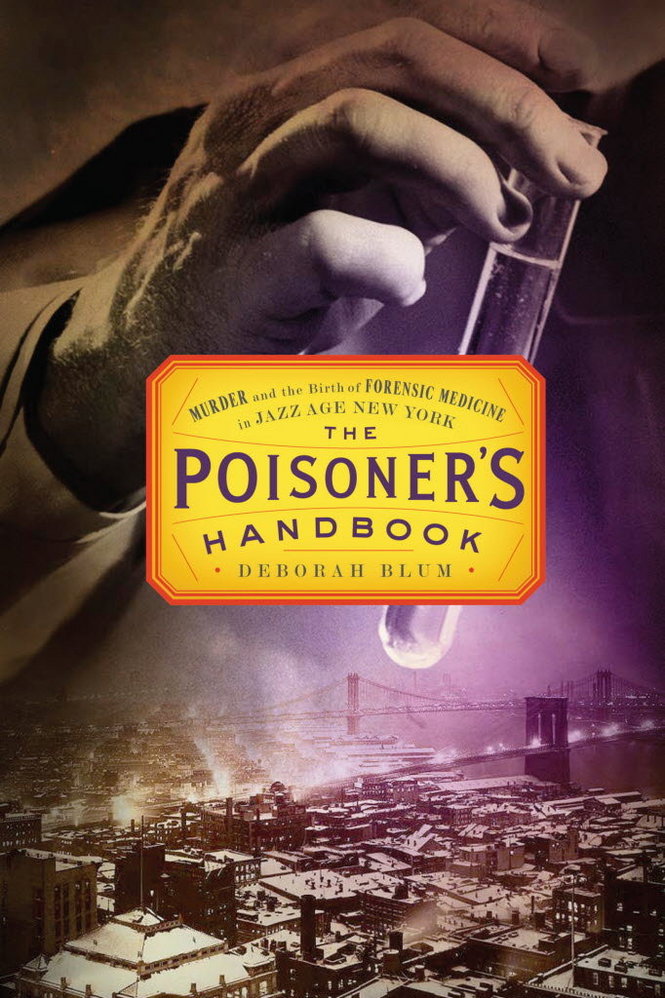Deborah Blum
Books: History | Science | Crime
The Poisoner's Handbook: Murder and the Birth of Forensic Medicine in Jazz Age New York (2010), Angel Killer: A True Story of Cannibalism, Crime Fighting, and Insanity in New York City (2012)
The Poisoner's Handbook: Murder and the Birth of Forensic Medicine in Jazz Age New York (2010)
 I think that anyone who enjoys mysteries has to be at least a little bit fascinated with poisonings and forensic medicine, and The Poisoner's Handbook looks at the beginning of forensic medicine and the circumstances that allowed it to develop in New York City (and then the rest of the United States).
I think that anyone who enjoys mysteries has to be at least a little bit fascinated with poisonings and forensic medicine, and The Poisoner's Handbook looks at the beginning of forensic medicine and the circumstances that allowed it to develop in New York City (and then the rest of the United States).
Each chapter of the book is based upon a poison and a time period, and those two threads are intertwined with Prohibition and crime and Tammany Hall in New York City, as well as the individuals who became the city's first forensic detectives and invented much of the science they used discover the various poisons.
Each chapter also contains one or more murder cases, to expand upon the poison and how it was obtained, as well as the effects that poison has upon the body.
That is a lot of material to cover, but from the point of view of the author, those events are so intertwined that they cannot be separated from one another, but taken together led to the creation of a proper medical examiners office in New York City.
Of course the most prominent poison–the one that threads through the entire story, is alcohol. Prohibition–the time span in which the book is set–led to many political and social changes not just in New York City, but in the United States as a whole. It's also far more interesting of a poison than you would expect, especially since methanol, or wood alcohol, plays a prominent part in the story.
Some parts of the book are not for the feint of heart. She describes in detail the physiological and biological changes ingestion (or inhalation) of each poison causes, and most of these are quite gruesome. She also describes the techniques the medical examiners needed to use to determine what poison caused the death.
These descriptions, however, are not gratuitous, but rather matter-of-fact. It's just that a description of making a brain slurry can be a little disturbing if you really think about it.
Although I wasn't enamored with the way the book was laid out, I do understand why she chose to organize it in that manner–there is a fair amount of science discussed, and to jump from poison to poison while following a strict time-line–or to jump back and forth in time while looking at a particular poison–would have been extremely confusing. So I didn't love it, and I think it made some of the chapters a bit choppy in places, but I don't think there was necessarily a better way to organize the story.
If you are interested in forensic medicine and murder and mystery, then I do recommend The Poisoner's Handbook.
Rating: 7/10
Angel Killer: A True Story of Cannibalism, Crime Fighting, and Insanity in New York City (2012)
 If you're looking for a light happy story–this is not the correct place to look.
If you're looking for a light happy story–this is not the correct place to look.
This is a true crime history of a man who kidnapped, tortured–and in some cases–at children.
That's now why I read this.
It also looks at criminology and psychiatry and the insanity defense in the early 20th century.
Here's an excerpt of a bit I found fascinating:
At the time, psychiatrists like Wertham who worked with the mentally ill, especially within the legal system, were still known as alienists–from the French word aliene, "insane." The etymology traced back further, to the Latin of the middle ages, alienare, "to deprive of reason." The term held another meaning, however, beneath it's scholarly surface. There was a sense that alienists studied aliens, denizens of some separate community of craziness.
But I also find it fascinating how some link religious imagery to serial murder. Here is a statement from the killer,
"I had sort of an idea through Abraham offering his son Isaac as a sacrifice," Fish explained. "It always seemed to me that I had to offer a child for sacrifice, to purge myself of inequities, sins, and abominations in the sight of God."
Considering some of the stories in the Torah, it seems to me we're lucky that more people don't take the wrong ideas from these stories of God.
Regardless, it was an interesting tale, but then I quite like Deborah Blum's writing.
Published by The Atavist
Rating: 8/10
